Beyond Triggers - The Power of Glimmers
Beyond Triggers - The Power of Glimmers by Elaine Rumboll
Intro: In an age of "Triggers," a counter-impulse known as "Glimmers" emerges, offering an accessible means of fostering joy and peace.
In Patrick Rothfuss' captivating novels, "Glamours" are enchanting spells that project an illusion of wealth, beauty, and well-being to enhance the appearance of people and objects. While these illusions may be fleeting, there is a way to build your own version of Glamours through "Glimmers." Researcher Deborah Dana has identified micro-moments that can have a lasting impact on our happiness. In a world full of "triggers," it's not surprising that "Glimmers" are gaining recognition. These brief moments can evoke feelings of joy or tranquillity, signalling to our nervous system that it's safe to relax.
Deb Dana, a licensed clinician social worker specialising in complex trauma, first coined the term "Glimmers" in her 2018 book, "The Polyvagal Theory in Therapy." Glimmers are fleeting moments that incrementally transform our systems. They can be found in nature's beauty, the company of animals, and the warmth of a stranger's smile. These Glimmers resonate with our minds due to the energy they emit. While everyone can benefit from acknowledging Glimmers, those who have experienced trauma may find them particularly valuable for fostering compassion and resilience. Our minds are wired to detect and solve problems, keeping us physically safe but potentially draining our emotional and psychological resources. By consistently recognising and appreciating minor, positive experiences, we can reshape our systems to foster mental and physical well-being. In this way, "Glimmers" evoke feelings of relaxation and hope, contrasting sharply with "triggers," which can activate stress responses.
Glimmers manifest in various forms, such as transient moments of natural splendour, a stranger’s kindness, or brief sensory experiences bringing inner calm or delight. Glimmers are tiny, often private moments that serve to lift the corners of your mouth for an instant. It could be as small as experiencing the texture of a fabric, the smell of jasmine on the wind, a birdcall in the early morning, a smile from a stranger in traffic.
Glimmer hunting can also include:
An intentional Awe walk immersing oneself in nature's grandeur, whether through strolls in the park, lakeside relaxation, or sunrise and sunset viewings.
Listening to uplifting or soothing music to improve mood and calm nerves.
Engaging in acts of kindness for oneself or others to elevate collective spirits.
Practising meditation or deep breathing to reduce stress and anxiety.
Cultivating gratitude by reflecting on blessings or maintaining a gratitude journal
To embrace Glimmers, set an intention for yourself, such as seeking out one Glimmer before lunch. A Glimmer journal can serve as a repository for daily reflections and discoveries, and sharing your Glimmer journey with loved ones can foster deeper connections. By granting ourselves permission to pursue positive feelings and experience these ephemeral Glimmers, we signal to our bodies a state of well-being and ease. The more we practise Glimmer-hunting, the more likely we are to uncover a wealth of Glimmers that anchor, protect, and soothe us. By consciously attending to these moments and intentionally seeking them out, we can create our own lasting enchantments and ultimately attain a more sustainable sense of ease, contentment and calm. In a world focused on triggers, Glimmers provide a vital counterbalance, reminding us to cherish the small moments of joy and serenity that fill our days.
Building Your Own Glimmer WorkSheet
Set aside an hour for this exercise. Find a comfortable position to sit in. Put a heavy shawl around your shoulders as you do this exercise. Do three rounds of breathing in through your nose for 4, holding for 6 and breathing out through your nose for a count of 8. Drop into your body and stay there. Repeat the breathwork when you feel like you are going back into your head.
1. Explore what makes you happy, what makes you feel peaceful and comfortable, and what sparks pleasant feelings for you. The following suggestions could serve as prompts for you:
What activities in your free time bring you joy?
Which sensations (sights, sounds, smells, textures, movements) do you find the most calming or enjoyable?
When you think back on your life, what small moments or experiences have made you the happiest?
Make a list of all these things and don’t self-edit yourself.
2. Once you have a list of possibilities, pick one or two that you want to actively pursue and enjoy in the days ahead.
3. Make it your mission during the following three days to actively pursue and enjoy the glimmers of happiness that most appeal to you. Planning a specific activity or just keeping an eye out for happy moments in your daily routine can help.
4. Pay close attention to the physical and mental effects of your chosen glimmers as you seek them out and experience them. How do they make you feel? How does your body react when you go through these things? Have you noticed a shift in your disposition, vitality, or perspective?
5. Finally, think about how your glimpses have strengthened your hope and resilience. How did actively seeking out and enjoying these joyful times aid you in weathering times of difficulty or stress? What did you learn about your emotional needs and how to meet them?
Remember, the goal of exploring Glimmers is to cultivate a habit of seeking out and appreciating the small moments of joy and connection in your daily life. By intentionally cultivating positive experiences and emotions, you can build emotional resilience and promote well-being even in the face of stress and adversity. It’s time to Get Your Glimmer On!
The Power of Play - Joyous Surprise at the end of a Keynote Address
I gave a keynote on the Power of Play at CounterPlay15 in Denmark a few days ago. At the end of the talk, I asked the 250 participants whether they would prefer to have a Q&A or a game instead. The unanimous agreement was, "A game."
This was the result....a tangible enactment of the Power of Play to connect and energise, and a reminder that it is in Play that we develop incredible insight and agility.
Leading with PACE: Better Business Impact without the Burnout
 With news that South Africa faces a real slowdown in terms of economic growth for 2014 and forecast for even greater downward trends in 2015, the questions become, "How does one do more with less? How does one run a business which can create a better business impact without increasing the burnout of one's employees and one's self?"
There is a new model for leadership which addresses these things. It is called PACE based leadership. Its philosophical underpinnings are grounded in four new leadership practices which take into account the need to create greater traction with less resources. Leading with PACE focuses on Play, Agility, Curiosity and Energy to achieve this.
With news that South Africa faces a real slowdown in terms of economic growth for 2014 and forecast for even greater downward trends in 2015, the questions become, "How does one do more with less? How does one run a business which can create a better business impact without increasing the burnout of one's employees and one's self?"
There is a new model for leadership which addresses these things. It is called PACE based leadership. Its philosophical underpinnings are grounded in four new leadership practices which take into account the need to create greater traction with less resources. Leading with PACE focuses on Play, Agility, Curiosity and Energy to achieve this.
 When leaders adopt a playful mindset to the work which needs to get done, they become more comfortable in a world where boundaries aren't clearly defined and the landscape changes at a rate which is difficult to predict. It is not so much about building play activities into one's job. It is more about reminding oneself that when one is playful, we bring a sense of the present, of being mindful in the moment and a sense of focus to the work we are engaged in.
When leaders adopt a playful mindset to the work which needs to get done, they become more comfortable in a world where boundaries aren't clearly defined and the landscape changes at a rate which is difficult to predict. It is not so much about building play activities into one's job. It is more about reminding oneself that when one is playful, we bring a sense of the present, of being mindful in the moment and a sense of focus to the work we are engaged in.
There has always been a misguided comfort in the belief that the Business of Business is Business. Unfortunately this kind of thinking leaves one open to the very real danger of Overseriousness where work no longer feels like an adventure, where we start feeling cynical about the processes we are engaged in, disconnected from our colleagues, fueled with fatigue at what lies ahead and scared of taking risks and innovating beyond the known.
For Lego, the largest toy company in the world, when we adapt a playful approach, when we remember the joy of seeing work as play, as the place where we don't know the outcome of our endeavour, our attitudes change; we become more courageous and realigned to the work we do.
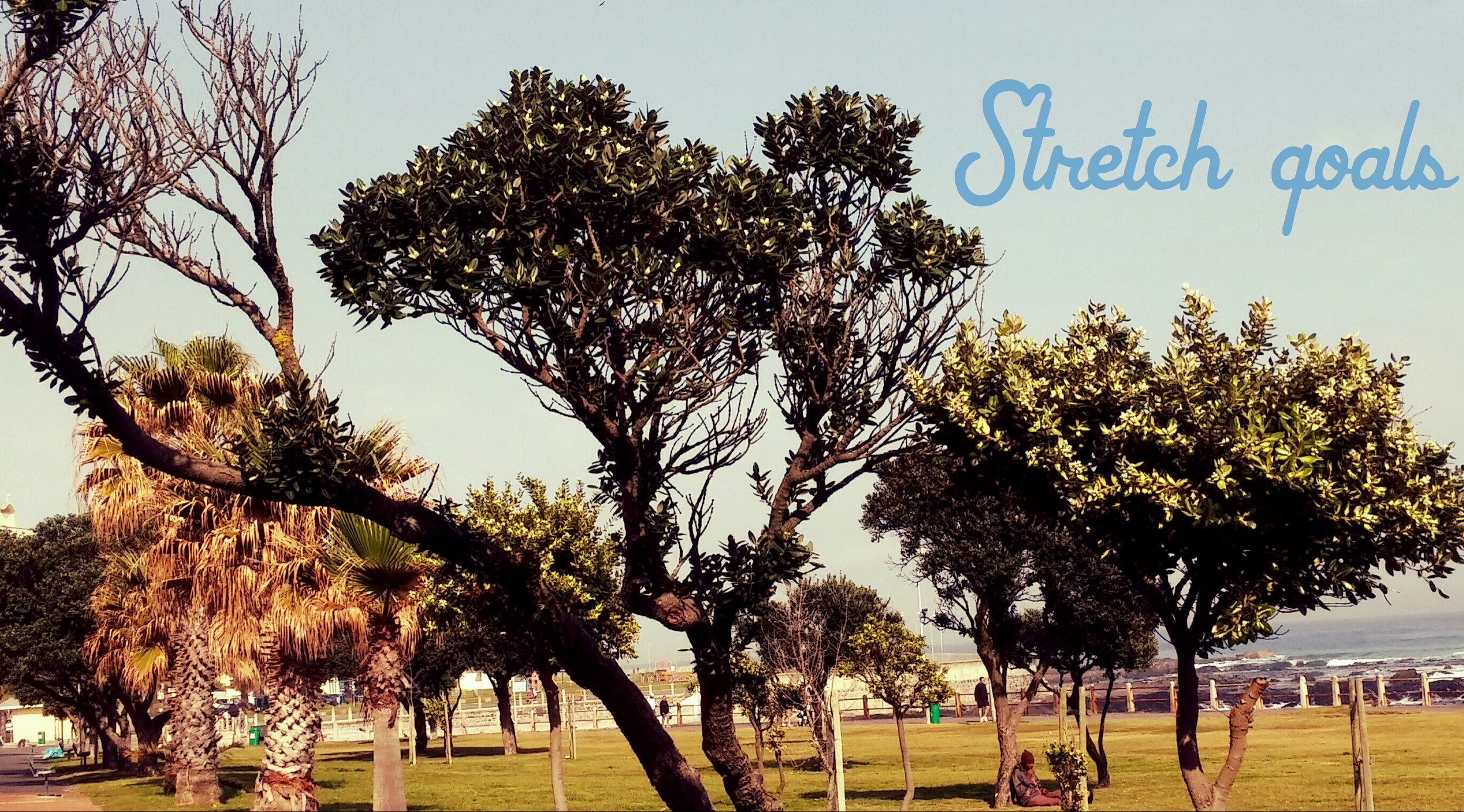 Agility, the second part of the Pace based leadership model reminds us that being comfortable with changing course mid-direction is an important leadership quality to be able to call on. Apple is notorious for driving its professionals crazy for their constant mid directional changes. They are however changes which have built it into the most admired company, according to Forbes, in the world. Agile leaders are able to better mitigate their risks and hear the footsteps of the future approaching. Being agile, like being playful, is never just about one decision. It is an approach to leading.
Agility, the second part of the Pace based leadership model reminds us that being comfortable with changing course mid-direction is an important leadership quality to be able to call on. Apple is notorious for driving its professionals crazy for their constant mid directional changes. They are however changes which have built it into the most admired company, according to Forbes, in the world. Agile leaders are able to better mitigate their risks and hear the footsteps of the future approaching. Being agile, like being playful, is never just about one decision. It is an approach to leading.
Curiosity, the third piece to the PACE model of leadership, is an enabler of agile and playful practices. When we are curious, we notice other opportunities, we let go of our assumptions and make better commercial decisions; curious leaders are more able to rid themselves of dogma, prejudice and judgement. Being able to notice helps us to unlearn, to begin again in the middle, if need be.
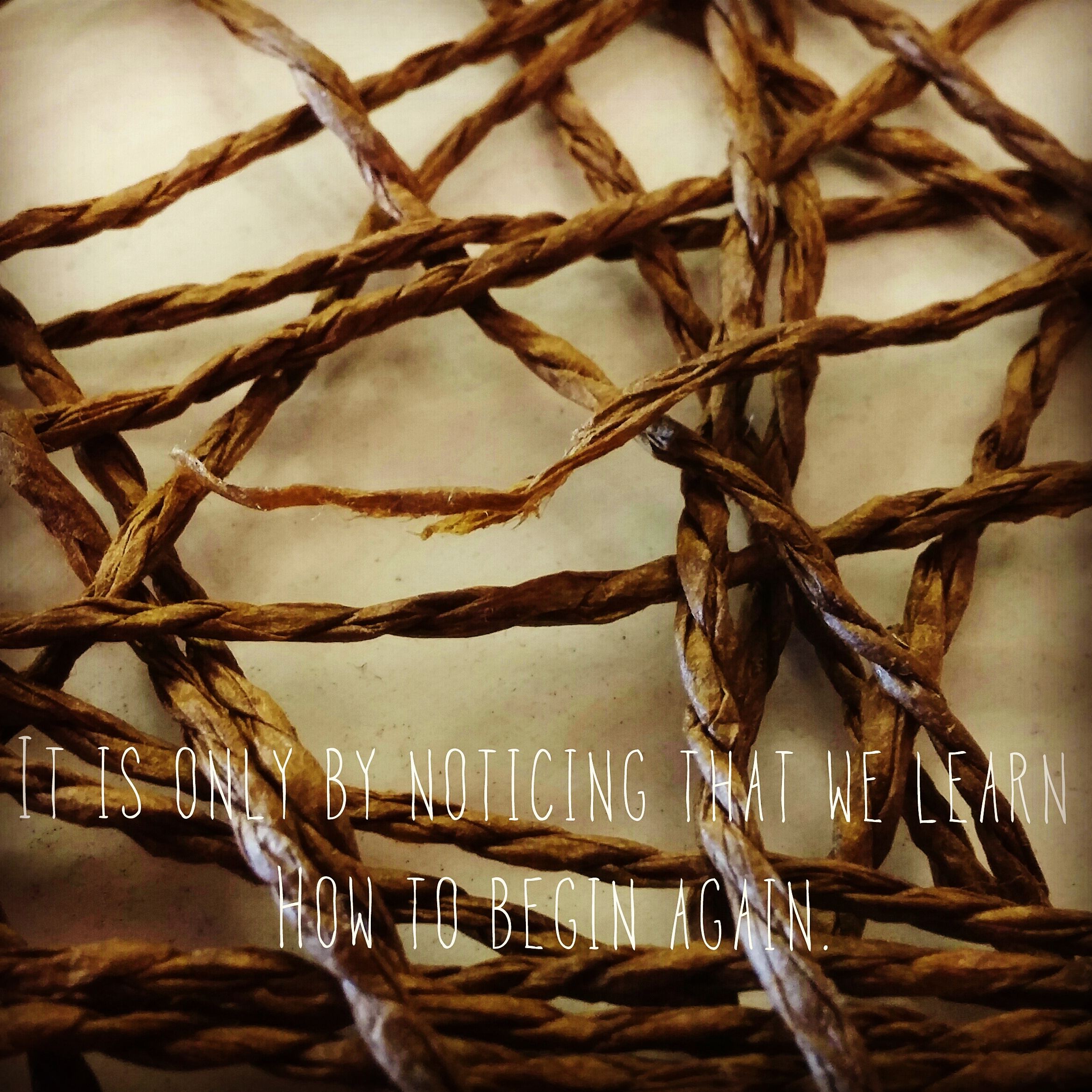 When we lead with PACE, we lead at a rate that feels resonant for each and every one of us. It requires that we change our mindset from focusing on the time we have available to the energy required to complete the task at hand.
When we lead with PACE, we lead at a rate that feels resonant for each and every one of us. It requires that we change our mindset from focusing on the time we have available to the energy required to complete the task at hand.
Leading with PACE gives us the tools to reframe our thinking, engage and connect meaningfully with others and avoid the burnout so often associated with trying to match the speed of the environment we are operating in. It provides counter tools to the traditional methods of control and command and enables leaders to reshape their leadership challenges with energy, ease and insight.
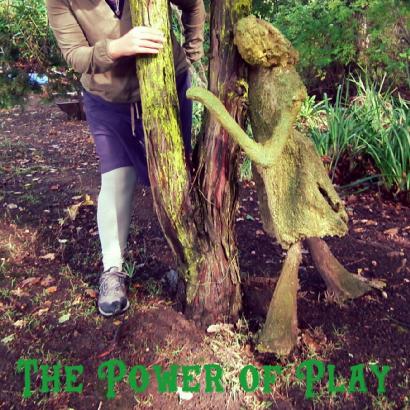 Elaine Rumboll has developed a one day masterclass on Leading with PACE. The programme has been designed for organisations looking to generate a more meaningful impact through less resources, and to gain more traction through a more fulfilling way of leading and doing. For a detailed description of what the masterclass entails, download the pdf here.
Elaine Rumboll has developed a one day masterclass on Leading with PACE. The programme has been designed for organisations looking to generate a more meaningful impact through less resources, and to gain more traction through a more fulfilling way of leading and doing. For a detailed description of what the masterclass entails, download the pdf here.
The Dangers of Overseriousness
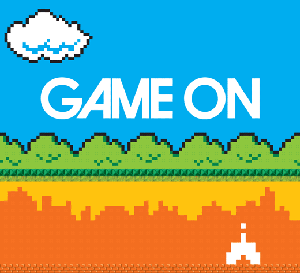 It is ironic that we are hard wired to include the word 'fear' when we speak of Uncertainty - the fear of the unknown, fear of failure, fear of judgement. However if we look at artistic and entrepreneurial practice, all efforts at innovation, creativity and engagement come from a place of NOT knowing what the outcome will be. It is in this place of not knowing that we create, connect and innovate. It seems that it is the nature of creativity to come from a place of uncertainty.
History is peppered with stories of people who started off believing they were inventing one thing and ended up inventing another. It is precisely this uncertainty which is at the heart of innovation which allows for something different to emerge when we trust the process and allow it to unfold into what can be.
It is ironic that we are hard wired to include the word 'fear' when we speak of Uncertainty - the fear of the unknown, fear of failure, fear of judgement. However if we look at artistic and entrepreneurial practice, all efforts at innovation, creativity and engagement come from a place of NOT knowing what the outcome will be. It is in this place of not knowing that we create, connect and innovate. It seems that it is the nature of creativity to come from a place of uncertainty.
History is peppered with stories of people who started off believing they were inventing one thing and ended up inventing another. It is precisely this uncertainty which is at the heart of innovation which allows for something different to emerge when we trust the process and allow it to unfold into what can be.
There is however another place where uncertainty is inherent in the system but does not bring with it the accompanying feeling of fear. That is in the place of Play. When we play, we have no idea of what the outcome will be. Play is always accompanied by uncertainty, not knowing what the end result will look like. However Play is also fun. It is an immersive experience of flow, of being energised in the moment and losing oneself in the joy of an experience. When we try to control the outcome of an experience, we go out of Play and into a place of performance anxiety.
There is a direct relationship between playing well and leading well in business today. Both have uncertainty as systemic in their systems. We no longer operate in environments where we can clearly delineate the boundaries of our operations, our competitors often come from disparate industries. If one attempts to lead in this environment with an 'overseriousness', the consequences are dire. We run the risk of creating stifling environments because people become scared to immerse themselves in the uncertainty and just stick to the well traveled path. By not equating work with a place of fun, of emergence we run the risk of getting stuck in systems that are mediocre, we run the risk of increasing bureaucracies. When you replace overseriousness with the spirit of play, it does not mean that you are not accountable for results: scores are part of the game.
At work, we want fully engaged teams that understand their roles in the state of play, where we don't assume fixed odds. No game is ever predictable so why do we treat our businesses as if they are?
We talk so much about teams, rewards, awards, competition in the jargon of business but the direct concept of Play even in its structured form is considered anathema to the 'serious business' of business. Consider a game like football, where all the players are expected to be in top form, but yet the outcome of each game is unpredictable. It wouldn't be exciting if people couldn't be trusted to improvise and take the risks necessary to achieve extraordinary outcomes.
What could Leadership look like if we treated it as a state of Play?
A playful leader energises other by bringing with them a sense of infectious fun, challenge, and the possibility of glorious achievement. The team’s flow and sense of involvement is more important than any individual act. The spirit of the game is all important - it is here where both the rules of the games and the relationships in the game matter.
Improvisation would be encouraged. We would allow for stellar acts of personal achievement - which we would reward and celebrate. Camaraderie and the spirit of fair play would be emphasised over the achievement of results at all costs. Here opportunities for people to connect matter . For one cannot play well together unless you connect well together. It is no small irony that the first thing to go when budgets are tight are the social activities. However, these are not indulgences, or frivolities but critical to the heart of play and possibility.
In Play we see other options. Sometimes playing through our most difficult challenges allows us to see other solutions as I so often see in the Lego Serious Play coaching I do. So if you want to avoid the dangers of overseriousness, which brings with it disengagement, mediocrity as a result of fear of failing, and bloated bureaucracies, embrace Play as a powerful leadership tool.
How PACE based leadership can energise your business
How often have you been requested to a meeting and dreaded it? Not just because of the fact that they often tend to be dreary and unproductive but also because they are seldom a place for sparking anything new. This is often because people come to meetings stuck in a particular position or mindset. I have developed a model which can, among other things, be applied to renergise a meeting place. It is based on work I have developed around what I have termed PACE based Leadership. The approach draws on four key leadership practices which are required to build highly functional teams, perspectives to be used when grappling with challenges and rethinking new approaches to things. At the heart of PACE based leadership is the emphasis on Play, Agility, Curiosity and Energy as critical leadership practices for today. Leading at PACE is a counter to the attempt to work faster in order to deal with the every increasing complexities and uncertainties of modern day business. For if we understand how to Play, embrace our own curiosity, learn to be more adaptable in the work we do and focus more on managing our energy than our time, the level of resonance and quality of our output is bound to improve.
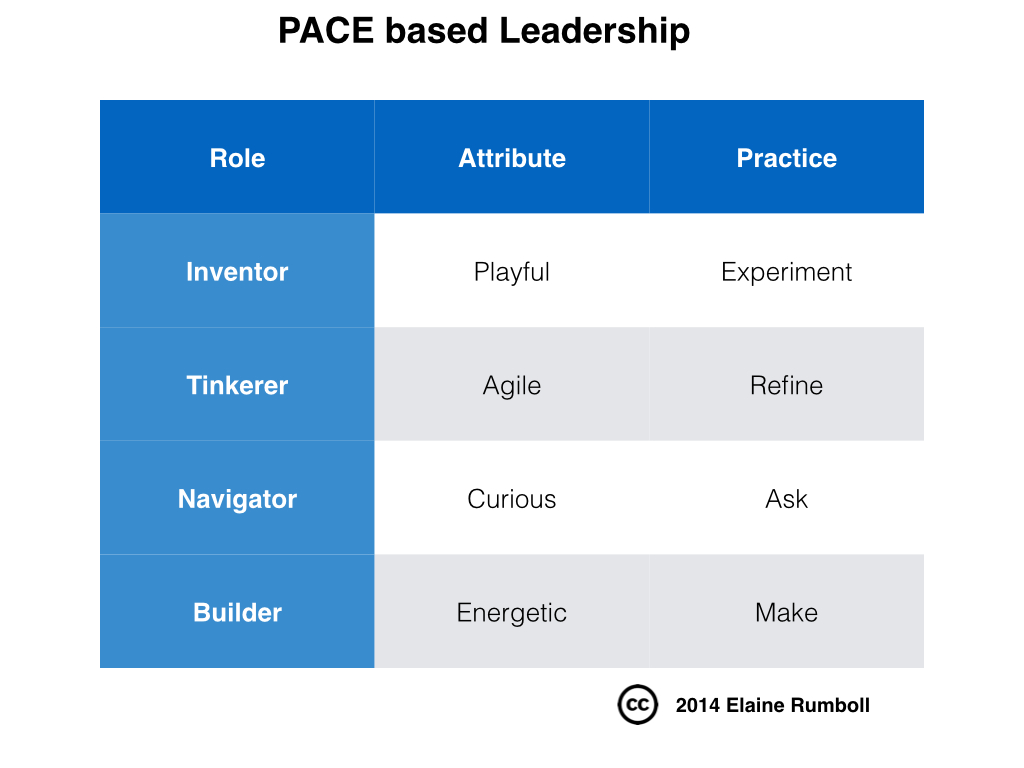 Inventors dream up new products, services and processes.
Inventors dream up new products, services and processes.
Tinkerers adapt and improve on the services and products offered.
Navigators set the direction, whilst ensuring the selection, cohesion and synthesis of all the elements
Builders turn ideas into executionable realities
I think that each of these roles requires a focus on a very particular leadership practice in order for their efforts to be effective and sustainable.
Navigators must be Curious
Proust said, "In order to discover new land, one must lose sight of the shore for a very long time". One of the dangers of being a leader is how easy it is to lose sight of one's own role. Power has a fascinating way of making people believe they are invincible, above the morals of lesser mortals; there is also a tendency to believe that one's own solutions are the correct ones. What a healthy dose of curiosity does is to allow for one to be less dogmatic, see other opportunities and other perspectives whilst increasing commercial acumen and mitigating risk. Be fascinated by your own ignorance and see what changes for you.
Tinkerers must be Agile
When one is required to improve a system or change a process, the default response is to look to where it has worked best elsewhere. The danger in this is that each organisation has an internal readiness to change which can only be adopted through the hearts and minds of others who work there. Lego didn't almost collapse because they tried new things. Their system almost imploded because they did not have the cultural willingness for the innovations they were experimenting with. The conceptual conundrum is that organisations are complex, adaptable systems so a simple causal approach to how systems should be changed is bound to land up a failure. Forget about best practice. Look for a new practice which is congruent with where your organisation is, and one which is easily adopted by the current culture.
Inventors must Play
There is enormous pressure on people working in the arena of product and business development to come up with the new. It breeds an overseriousness which can in fact lead to mediocrity and a stifling overbureaucratisation. What Play does is that it moves people out of Ego and into a state of flow. Play makes one more adaptable to change, more emotionally resilient and more open to testing and experimenting with alternatives.
Builders must have Energy
In order to get things done, one needs to recruit the service of others. Above all things this requires energy; energy which is both in the doing and in the motivating of others. Focus on what needs to get done not on how people are going to get it done. Manage their deliverables not their time.
So why not assign these roles at your next meeting - a navigator, a tinkerer, an inventor and a builder. Experiment by first assigning them to ones who obviously fit these roles and then do another round, let them pick a role randomly out of a hat and try to see things from a perspective which is not familiar. Request that their attitude fit their role, be it playful, curious, energised or adaptable. Ask them to use the lens of experimentation, refining, building or making for how they respond to challenges and opportunities raised in your meeting. See what changes, how people shift and what kind of fresh eyed thinking comes out.


